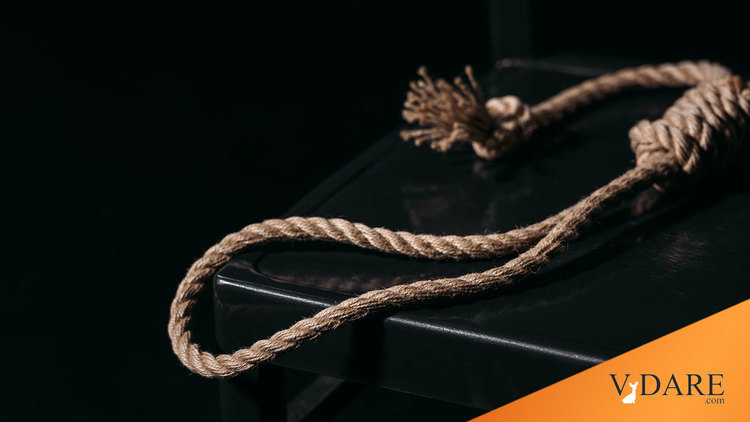During his much-heralded speech on race relations, Barack Obama bemoaned the idea that "We can tackle race only as spectacle." Calling the manufactured hysteria about the alleged proliferation of noose hangings across the country a "spectacle" would be an understatement. But now both federal and state governments are trying to "tackle" this problem by passing "hate crime" legislation.
Recently, the state legislatures of Maryland and Connecticut took significant steps towards banning nooses. The Maryland House of Delegates voted 111 to 20 to give up to three years in prison and a 5,000 dollar fine for the offense. Connecticut's judiciary committee unanimously approved a similar measure 43-0. A bill has already been enacted in Michigan and one is underway in the District of Columbia.
According to Saqib Ali, a Maryland State representative whose parents came from Pakistan, and who cosponsored the bill in Maryland, "The noose is the premier symbol of hatred now, people don't burn crosses anymore." [Law Would Ban Noose Display, By Kate Queram, Capital News Service, March 21, 2008] The bill failed, but in all such attempts to pass bad laws, the legislators only have to be lucky once.
Since the abolition of slavery, over 3,000 African Americans and 1,200 whites were lynched without fair trial. Though the majority of lynchings were for serious crimes like murder and rape, there are 85 known cases where blacks were lynched merely for insulting whites. (Statistics on lynching are kept by Tuskegee University.) In light of this history, a noose can have extremely racist and threatening connotations.
However, unlike cross burnings, nooses did not ipso facto represent racism and oppression until recently. Depending on the context, they could be a symbol of mob justice or tough law and order. In the Old West, the "vigilantism" of which the Minutemen are so frequently accused was a matter of whites hanging other whites, such as cattle rustlers or other criminals.
Thus in 2003, Willie Nelson and Toby Keith scored a number one hit with "Beer for My Horses." In the duet, the left wing Nelson sang, "Take all the rope in Texas, Find a tall oak tree, Round up all of them bad boys, Hang them high in the street." This song attracted no controversy—unlike Keith's pro-War on Terror anthem Courtesy of the Red White and Blue.
In 2006, a major factor leading to George Allen's defeat in Virginia was his alleged racial insensitivity in calling an Indian Jim Webb supporter "Macaca," which Allen's opponents claimed was meant as a racial slur. But even in this racially charged campaign, the fact that he once had a noose outside his office while a district attorney failed to gain any traction. Voters understood that in proper context, Allen's display did not represent racism.
Yet just one year after Allen's defeat, the noose has come to embody all that is racist in our society:
These are not isolated instances of political correctness. Both Hillary Clinton and Barack Obama have made nooses and the Jena 6 incident into campaign issues. Even President Bush made nooses a central theme to his Black History Month speech. He claimed: "The noose is not a symbol of prairie justice, but of gross injustice." (So much for Willie Nelson).
What has happened in the last year that justifies turning nooses into the new swastika? It all began with the now infamous Jena Six case in Louisiana. The story concocted by the Left and parroted by the media is that white students at Jena High School hung a noose on a tree to intimidate black students. A school yard scuffle broke out, and the six blacks involved were charged with attempted murder, while the whites who hung the noose were given a slap on the wrist.
In reality, the nooses were hung in school colors by historically illiterate students prior to a football game, aimed at a rival school with a Western-themed team. Three months later, six black students, some of whom had extensive criminal records, beat an isolated white student who had absolutely nothing to do with the nooses. The vice principal of the school who found him thought he was dead.
In the wake of the case, the noose "epidemic" began. The highest profile incident occurred when Columbia University professor Madonna Constantine claimed a noose was hung outside of her office. It has since came out that Prof. Constantine was in the midst of a plagiarism investigation when the noose appeared. The police are now subpoenaing Columbia records to see if she was the perpetrator.
Similarly, a number of other "victims" of nooses such as a Baltimore firefighter suspected of cheating on his exams and a Lowe's employee charged with internal theft failed to raise flags, and were later shown to be hoaxes.
There has yet to be a single noose incident that was followed by violence.
But in all cases, politicians and civil rights demanded harsh punishment for the offenders and a media circus ensued. When they were exposed as frauds, there was little reprimand or media coverage for the hoaxers.
Many states have imposed restrictions on swastikas and burning crosses. In 2004, the Supreme Court upheld a Virginia law that banned most cross burnings even on private property. The argument is that their intent is to intimidate and they are therefore not free speech.
That a symbol is not exclusively associated with racism is now getting the same treatment is more evidence of America's slide down the slippery slope towards criminalization of an ever expanding definition of "hate speech."
Not for the first time, diversity proves to be, not strength, but tyranny.
Marcus Epstein [send him mail] is the founder of the Robert A Taft Club and the executive director of the The American Cause and Team America PAC. A selection of his articles can be seen here. The views he expresses are his own.













